5
1
9783642491139


Basics of Acupuncture available in Paperback

Basics of Acupuncture
- ISBN-10:
- 3642491138
- ISBN-13:
- 9783642491139
- Pub. Date:
- 05/05/2012
- Publisher:
- Springer Berlin Heidelberg
- ISBN-10:
- 3642491138
- ISBN-13:
- 9783642491139
- Pub. Date:
- 05/05/2012
- Publisher:
- Springer Berlin Heidelberg
54.99
In Stock

Product Details
| ISBN-13: | 9783642491139 |
|---|---|
| Publisher: | Springer Berlin Heidelberg |
| Publication date: | 05/05/2012 |
| Edition description: | 1995 |
| Pages: | 314 |
| Product dimensions: | 5.00(w) x 7.99(h) x 0.03(d) |
About the Author
From the B&N Reads Blog
